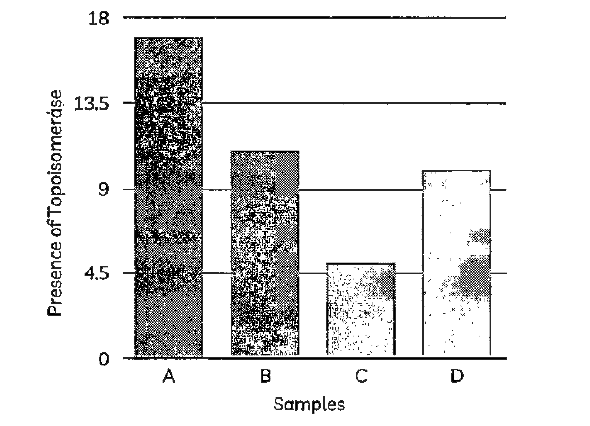The proof for semiconservative mode of DNA replication was First provided by Matthew Meselson and Franklin Stahl. Escherichia coli were the first organism to be used for this experiment and then it was done in with higher organisms such as plants and human cells. The process of DNA replication in terms of energy is a very expensive process. It involves the formation of a replication fork. Given below is a graph showing the percentage of Adenine in two different double stranded DNA.
Study the graph given below. One of the samples will easily sail through the supercoiling developed on the end of DNA opposite to the replication fork. The sample will be:

A
B
C
D
The correct Answer is:A
Unwinding of DNA by helicases results in formation of a Y-shaped replication fork. The exposed single strands are stabilised by SSB or the single strand binding Protein. The SSB.s hold open the strands to form replication fork. Topoisomerase enzyme releases the tension in the DNA strands or supercoiling created by unwinding of DNA. Sample A has maximum percentage of Topoisomerase and hence it will undergo a quick release from this supercoiling.
Topper's Solved these Questions
Similar Questions
Knowledge Check
The proof for semiconservative mode of DNA replication was First provided by Matthew Meselson and Franklin Stahl. Escherichia coli were the first organism to be used for this experiment and then it was done in with higher organisms such as plants and human cells. The process of DNA replication in terms of energy is a very expensive process. It involves the formation of a replication fork. Given below is a graph showing the percentage of Adenine in two different double stranded DNA.
Helicase helps in:AStabilising the strandsBUnwinding the helixCFormation of primer strandDAll of them.The proof for semiconservative mode of DNA replication was First provided by Matthew Meselson and Franklin Stahl. Escherichia coli were the first organism to be used for this experiment and then it was done in with higher organisms such as plants and human cells. The process of DNA replication in terms of energy is a very expensive process. It involves the formation of a replication fork. Given below is a graph showing the percentage of Adenine in two different double stranded DNA.
Meselson and Stahl provided confirmation to whose model of DNA?ALinus PaulingBJohann Friedrich MiescherCWatson and CrickDNone of theseThe proof for semiconservative mode of DNA replication was First provided by Matthew Meselson and Franklin Stahl. Escherichia coli were the first organism to be used for this experiment and then it was done in with higher organisms such as plants and human cells. The process of DNA replication in terms of energy is a very expensive process. It involves the formation of a replication fork. Given below is a graph showing the percentage of Adenine in two different double stranded DNA.
DNA replication is often termed as a semi-discontinuous process because:AFormation of a primer strand takes place during replication of DNA.BHelicase unwinds the helix in phasesCOkazaki fragments are formed during DNA replication.DInformation insufficient
Semiconservative replication of DNA was first shown in
View SolutionThe proof for semiconservative mode of DNA replication was First provided by Matthew Meselson and Franklin Stahl. Escherichia coli were the first organism to be used for this experiment and then it was done in with higher organisms such as plants and human cells. The process of DNA replication in terms of energy is a very expensive process. It involves the formation of a replication fork. Given below is a graph showing the percentage of Adenine in two different double stranded DNA.
Turner's syndrome results due to ............... of one of the X chromosome.
View SolutionThe proof for semiconservative mode of DNA replication was First provided by Matthew Meselson and Franklin Stahl. Escherichia coli were the first organism to be used for this experiment and then it was done in with higher organisms such as plants and human cells. The process of DNA replication in terms of energy is a very expensive process. It involves the formation of a replication fork. Given below is a graph showing the percentage of Adenine in two different double stranded DNA.
Which among the following is the appropriate reason for Primase being the primary enzyme responsible for initiation of DNA synthesis?
View SolutionMode of DNA replication in E. coli is :
View SolutionMode of DNA replication in E. coli is :-
View Solution
